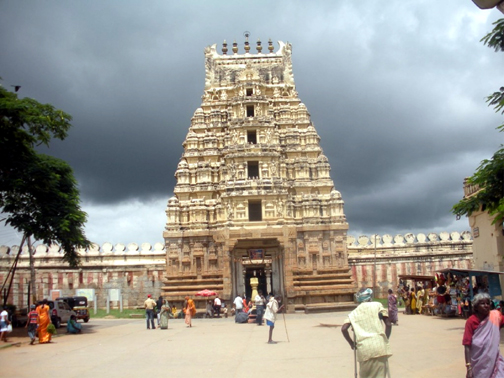O N Bhat Kuthari
Rameshwaram is one of the holiest four dIvine sites in the four corners of India, Badri Nath in the north, Puri in the east, Dwarika in the west and Rameshwaram in the south. It is one of the holiest Hindu Char Dhams. There is a traditional belief thatChota Char Dham yatra in the Himalayas (Badri Nath, Kedar Nath, Gangotri and Yamunotri) is in complete without the pilgrimage to Rameshwaram with the offering of holy Gangajal brought from holy Ganga on the holy Jyotir Lingam. The Ramanatha temple occupies a major area of Rameshwaram. As the whole Island is considered holy, people generally walk bare footed to keep the sanctity of the site. Ploughing is also considered a great sin.
THE TEMPLE:- The Ramanatha temple of Rameshwaram occupies a prime position in the list of most splendid monuments of India. The temple is one of the 12 Jyotirlinga temples where God is worshipped in the form of a Jyotirlingam meaning’ Pillar of ligt’. The Jyotirlinga is the supreme partless reality, out of which SHIVA partly appears. The Jyotirlinga shrines are places where Shiva appeared as a column of light. Though SHIVA is worshipped in several forms, the authentic form of worsip is the Lingam or SHIVLINGAM, Shivlingam consists of NADHAM of perpendicular stone and BRIDHAM round shaped stone. It represents the aspect of OMKARA PANVA. In this way it consists of Brahma, Vishnu Ruda and Shiva. The bottom portion is Brahma, the circular portion is Vishnu, the perpendicular portion is Rudra and the top most portion is Shiva. This represents, a,u,m. Shiva has rupam (form). He can be seen in Arupam (formless). Rupam and Arupam is SHIVLINGAM. The presiding deity of this holy site is Ramanatha Swamy (SHIVA) in the form of a Lingam. There are two lingams in the temple one made by Sita from the beach sand residing as the main deity in the Sanctum Sanctorum known as Ramalingam and the other brought by Lord Hunuman from Kailash called Vishwalingam. Hanuman brought two lingas in his two hands. The other one stands installed near the main gate. After killing Ravana, Sh. Rama Chander wanted to get absolved of the sin of Brahmahatya incurred by killing Ravana, who was a Brahmin. On the advice of sage Agasteya he wished to pray and worship SHIVA on this holy Island after returning from Lanka with Sita, winning the war. To worship God SHIVA, Sh. Ram wanted a big Shiv Lingam. He directed Hanuman to bring the lingam from the Himalayas. Hanuman did not return within the auspicious time (Mahurat), so SITA DEVI made a Shiv lingam of the beach sand which was worshipped by Sh. Ram, Sita, Lakshman and others in the presence of Devas, Sages and Rishis. SHIVA was also pleased to show His presence as a Jyoti (column of light) in the holy worshipped Shiv lingam to become Jyotirlingam to bless the worshippers and absolve Ram of the great sin. The same Jyotirlingam stands installed in the sanctum santorum of the temple. Then Ravana came with two Lingams in his two hands. He became disappointed. Sh. Ram to console him asked him to uproot the Lingam just worshipped. Hanuman with all his might could not do it as the Lingam has acquired divinity. In order to pacify Hanuman, Lord Ram got the Lingam brought by Hanuman installed nearby known as Vishwalingam and instructed that this Lingam should be worshipped first and them the Ram Lingam installed and worshipped by Him. The tradition continues even today.
There is another version that Rama installed and worshipped this holy Shiv Lingam before embarking on the war with Ravana to seek the blessings of Maha Deva.
The Rameshwaram temple dedicated to Lord SHIVA facing the sea is one of the most important temples in India from the view point of architecture, sculpture and stone carving. It stands out as a typical Dravidian in style. It is reputed for its magnificent three corridors with massive sculpture pillars lining them. The temple is 865 feet long and 657 feet broad. The ceiling supported by stone beams of 49 feet long. The Sanctum sanctorum is built of polished granite stones by Parakarma Bahu ruler of Ceylon. One of the wonders of the world is its three corridors having about 4000 feet length. On both sides of the corridors are platforms of 5 feet high on which stands stone pillars of 25 feet high. The temple Mandapam is supported by 1212 huge, giant monolithic pillars of black granite having outstanding sculptures of various deities. The temple has two gopurams (towers) of 130 feet and 80 feet high on the eastern side and western side respectively and finished gate towers on the north and the south. The temple complex is enclosed by walls. The temple is visited by the devotees from all corners of India and abroad. In addition to pilgrims, the temple drawa large number of historians, archeologists, art lovers and foreign tourists. There are two main Shakti Shrines in the temple complex. One is of Parvata Vardhani, consort of Shiva on the right side of Sanctum Santorum and the other is to the right side of Vishwalingam shrine, known as Vishalakhi, the consort of Vishwanatha. There is huge statue of Nandi 12 feet long and 9 feet high made of lime mortar at the entrance. Adjacent to the main gate is the statue of Hunaman. There are about 64 Tirthas (holy water bodies) in this sacred Island. According to the Skanda Purana, 24 of them are important and 22 tirthas are within the holy temple complex. Bathing in these holy Tirthas (Tankas) is a major auspicious aspect of the pilgrimage to Rameshwaram deemed to be an act of penance. The devotees get purified by washing of their sins by taking holy bath.
Trending Now
E-Paper


